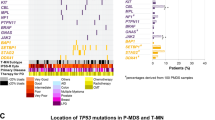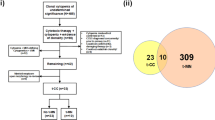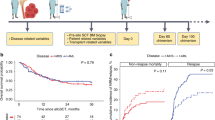Abstract
Therapy-related leukemia or myelodysplasia (t-leuk/MDS) is a serious problem that is increasing in frequency. We studied the clinical characteristics of 96 patients (pts) with a mean age of 48 years, and analyzed the molecular parameters that could predispose to t-leuk/MDS. Hematological malignancies were the most common primary (53%), followed by breast and ovarian cancer (30% combined). The mean latency until the development of t-AML was 45.5 months. Median survival was 10 months. Cytogenetics was abnormal in 89% of pts. FLT3 internal tandem duplications were found in six of 41 (14.6%) pts, of whom four had an abnormal karyotype. Analysis of drug metabolism and disposition genes showed a protective effect of the CYP3A4 1*B genotype against the development of t-leuk/MDS, whereas the CC genotype of MDR1 C3435T and the NAD(P)H:quinone oxidoreductase1 codon 187 polymorphism were both noncontributory. Microsatellite instability (MSI) analysis using fluoresceinated PCR with ABI sequence analyzer demonstrated that 41% of pts had high levels of MSI in four or more of 10 microsatellite loci. Immunohistochemistry demonstrated reduced expression of MSH2 and MLH1 in 6/10 pts with MSI as compared to 0/5 of pts without MSI. In conclusion, genetic predisposition as well as epigenetic events contribute to the etiology of t-AML/MDS.
This is a preview of subscription content, access via your institution
Access options
Subscribe to this journal
Receive 12 print issues and online access
$259.00 per year
only $21.58 per issue
Buy this article
- Purchase on Springer Link
- Instant access to full article PDF
Prices may be subject to local taxes which are calculated during checkout




Similar content being viewed by others
References
Pedersen-Bjergaard J, Andersen MK, Christiansen DH, Nerlov C . Genetic pathways in therapy-related myelodysplasia and acute myeloid leukemia. Blood 2002; 99: 1909–1912.
Pedersen-Bjergaard J . Molecular cytogenetics in cancer. Lancet 2001; 357: 491–492.
Rund D, Ben-Yehuda D . Therapy-related leukemia and myelodysplasia: evolving concepts of pathogenesis and treatment. Hematology 2004; 9: 179–187.
Das-Gupta EP, Seedhouse CH, Russell NH . DNA repair mechanisms and acute myeloblastic leukemia. Hematol Oncol 2000; 18: 99–110.
Ben-Yehuda D, Krichevsky S, Caspi O, Rund D, Polliack A, Abeliovitch D et al. Microsatellite instability and p53 mutations in therapy-related leukemia suggests mutator phenotype. Blood 1996; 88: 4296–4303.
Au WY, Fung AT, Ma ES, Liang RH, Kwong YL . Low frequency of FLT3 gene internal tandem duplication and activating loop mutation in therapy-related acute myelocytic leukemia and myelodysplastic syndrome. Cancer Genet Cytogenet 2004; 149: 169–172.
Michaeli J, Lerer I, Rachmilewitz EA, Fibach E . Stimulation of proliferation of human myeloid leukemia cells in culture: applications for cytogenetic analysis. Blood 1986; 68: 790–793.
Klinger HP . Rapid processing of primary embryonic tissues for chromosome banding pattern analysis. Cytogenetics 1972; 11: 424–435.
Chaudhary P, Roninson I . Expression and activity of P-glycoprotein, a multidrug efflux pump, in human hematopoietic stem cells. Cell 1991; 66: 85–94.
Abu-Duhier FM, Goodeve AC, Wilson GA, Gari MA, Peake IR, Rees DC et al. FLT3 internal tandem duplication mutations in adult acute myeloid leukaemia define a high-risk group. Br J Haematol 2000; 111: 190–195.
Felix CA, Walker AH, Lange BJ, Williams TM, Winick NJ, Cheung N-K et al. Association of CYP3A4 genotype with treatment-related leukemia. Proc Natl Acad Sci USA 1998; 95: 13176–13181.
Cascorbi I, Gerloff T, Johne A, Meisel C, Hoffmeyer S, Schwab M et al. Frequency of single nucleotide polymorphisms in the P-glycoprotein drug transporter MDR1 gene in white subjects. Clin Pharmacol Ther 2001; 69: 169–174.
Smith MT, Wang Y, Kane E, Rollinson S, Wiemeis JL, Roman E et al. Low NAD(P)H:quinone oxireductase I activity is associated with an increased risk of acute leukemia in adults. Blood 2001; 97: 1422–1426.
Lee JS, Paull K, Alvarez M, Hose C, Monks A, Grever M et al. Rhodamine efflux patterns predict P-glycoprotein substrates in the National Cancer Institute drug screen. Mol Pharmacol 1994; 46: 627–638.
Damiani D, Michieli M, Ermacora A, Candoni A, Raspadori D, Geromin A et al. P-glycoprotein (PGP), and not lung resistance-related protein (LRP), is a negative prognostic factor in secondary leukemias. Haematologica 1998; 83: 290–297.
Larson RA, Wang Y, Banerjee M, Wiemels J, Hartford C, Le Beau MM et al. Prevalence of the inactivating 609C → T polymorphism in the NAD(P)H:quinone oxidoreductase (NQO1) gene in patients with primary and therapy-related myeloid leukemia. Blood 1999; 94: 803–807.
Hoang JM, Cottu PH, Thuille B, Salmon RJ, Thomas G, Hamelin R . BAT-26, an indicator of the replication error phenotype in colorectal cancers and cell lines. Cancer Res 1997; 57: 300–303.
Percesepe A, Pedroni M, Sala E, Menigatti M, Borghi F, Losi L et al. Genomic instability and target gene mutations in colon cancers with different degrees of allelic shifts. Genes Chromosomes Cancer 2000; 27: 424–429.
Liu B, Nicolaides NC, Markowitz S, Willson JK, Parsons RE, Jen J et al. Mismatch repair gene defects in sporadic colorectal cancers with microsatellite instability. Nat Genet 1995; 9: 48–55.
Lamb P, Crawford L . Characterization of the human p53 gene. Mol Cell Biol 1986; 6: 1379–1385.
Nicolaides NC, Carter KC, Shell BK, Papadopoulos N, Vogelstein B, Kinzler KW . Genomic organization of the human PMS2 gene family. Genomics 1995; 30: 195–206.
Zhou XP, Hoang JM, Cottu P, Thomas G, Hamelin R . Allelic profiles of mononucleotide repeat microsatellites in control individuals and in colorectal tumors with and without replication errors. Oncogene 1997; 15: 1713–1718.
Parsons R, Myeroff LL, Liu B, Willson JK, Markowitz SD, Kinzler KW et al. Microsatellite instability and mutations of the transforming growth factor beta type II receptor gene in colorectal cancer. Cancer Res 1995; 55: 5548–5550.
Inoue K, Kohno T, Takakura S, Hayashi Y, Mizoguchi H, Yokota J . Frequent microsatellite instability and BAX mutations in T cell acute lymphoblastic leukemia cell lines. Leuk Res 2000; 24: 255–262.
Zhu YM, Das-Gupta EP, Russell NH . Microsatellite instability and p53 mutations are associated with abnormal expression of the MSH2 gene in adult acute leukemia. Blood 1999; 94: 733–740.
Olipitz W, Hopfinger G, Aguiar RC, Gunsilius E, Girschikofsky M, Bodner C et al. Defective DNA-mismatch repair: a potential mediator of leukemogenic susceptibility in therapy-related myelodysplasia and leukemia. Genes Chromosomes Cancer 2002; 34: 243–248.
Horiike S, Misawa S, Kaneko H, Sasai Y, Kobayashi M, Fujii H et al. Distinct genetic involvement of the TP53 gene in therapy-related leukemia and myelodysplasia with chromosomal losses of Nos 5 and/or 7 and its possible relationship to replication error phenotype. Leukemia 1999; 13: 1235–1242.
Smith SM, Le Beau MM, Huo D, Karrison T, Sobecks RM, Anastasi J et al. Clinical–cytogenetic associations in 306 patients with therapy-related myelodysplasia and myeloid leukemia: the University of Chicago series. Blood 2003; 102: 43–52.
van Leeuwen FE . Risk of acute myelogenous leukaemia and myelodysplasia following cancer treatment. Baillieres Clin Haematol 1996; 9: 57–85.
Takeyama K, Seto M, Uike N, Hamajima N, Ino T, Mikuni C et al. Therapy-related leukemia and myelodysplastic syndrome: a large-scale Japanese study of clinical and cytogenetic features as well as prognostic factors. Int J Hematol 2000; 71: 144–152.
Christiansen DH, Pedersen-Bjergaard J . Internal tandem duplications of the FLT3 and MLL genes are mainly observed in atypical cases of therapy-related acute myeloid leukemia with a normal karyotype and are unrelated to type of previous therapy. Leukemia 2001; 15: 1848–1851.
Horiike S, Yokota S, Nakao M, Iwai T, Sasai Y, Kaneko H et al. Tandem duplications of the FLT3 receptor gene are associated with leukemic transformation of myelodysplasia. Leukemia 1997; 11: 1442–1446.
Blanco JG, Edick MJ, Hancock ML, Winick NJ, Dervieux T, Amylon MD et al. Genetic polymorphisms in CYP3A5, CYP3A4 and NQO1 in children who developed therapy-related myeloid malignancies. Pharmacogenetics 2002; 12: 605–611.
Naoe T, Takeyama K, Yokozawa T, Kiyoi H, Seto M, Uike N et al. Analysis of genetic polymorphism in NQO1, GST-M1, GST-T1, and CYP3A4 in 469 Japanese patients with therapy-related leukemia/myelodysplastic syndrome and de novo acute myeloid leukemia. Clin Cancer Res 2000; 6: 4091–4095.
Hitzl M, Drescher S, van der Kuip H, Schaffeler E, Fischer J, Schwab M et al. The C3435T mutation in the human MDR1 gene is associated with altered efflux of the P-glycoprotein substrate rhodamine 123 from CD56+ natural killer cells. Pharmacogenetics 2001; 11: 293–298.
Siegsmund M, Brinkmann U, Schaffeler E, Weirich G, Schwab M, Eichelbaum M et al. Association of the P-glycoprotein transporter MDR1(C3435T) polymorphism with the susceptibility to renal epithelial tumors. J Am Soc Nephrol 2002; 13: 1847–1854.
Potocnik U, Ravnik-Glavac M, Glavac D . Functional MDR1 polymorphisms (G2677T and C3435T) and TCF4 mutations in colorectal tumors with high microsatellite instability. Cell Mol Biol Lett 2002; 7: 92–95.
Das-Gupta EP, Seedhouse CH, Russell NH . Microsatellite instability occurs in defined subsets of patients with acute myeloblastic leukaemia. Br J Haematol 2001; 114: 307–312.
Sheikhha MH, Tobal K, Liu Yin JA . High level of microsatellite instability but not hypermethylation of mismatch repair genes in therapy-related and secondary acute myeloid leukaemia and myelodysplastic syndrome. Br J Haematol 2002; 117: 359–365.
Casorelli I, Offman J, Mele L, Pagano L, Sica S, D'Errico M et al. Drug treatment in the development of mismatch repair defective acute leukemia and myelodysplastic syndrome. DNA Repair (Amst) 2003; 2: 547–559.
Rimsza LM, Kopecky KJ, Ruschulte J, Chen IM, Slovak ML, Karanes C et al. Microsatellite instability is not a defining genetic feature of acute myeloid leukemogenesis in adults: results of a retrospective study of 132 patients and review of the literature. Leukemia 2000; 14: 1044–1051.
Boyer JC, Risinger JI, Farber RA . Stability of microsatellites in myeloid neoplasias. Cancer Genet Cytogenet 1998; 106: 54–61.
Faulkner RD, Seedhouse CH, Das-Gupta EP, Russell NH . BAT-25 and BAT-26, two mononucleotide microsatellites, are not sensitive markers of microsatellite instability in acute myeloid leukaemia. Br J Haematol 2004; 124: 160–165.
Bacon AL, Dunlop MG, Farrington SM . Hypermutability at a poly(A/T) tract in the human germline. Nucleic Acids Res 2001; 29: 4405–4413.
Indraccolo S, Minuzzo S, Nicoletti L, Cretella E, Simon M, Papakonstantinou G et al. Mutator phenotype in human hematopoietic neoplasms and its association with deletions disabling DNA repair genes and bcl-2 rearrangements. Blood 1999; 94: 2424–2432.
Brimmell M, Mendiola R, Mangion J, Packham G . BAX frameshift mutations in cell lines derived from human haemopoietic malignancies are associated with resistance to apoptosis and microsatellite instability. Oncogene 1998; 16: 1803–1812.
Worrillow LJ, Travis LB, Smith AG, Rollinson S, Smith AJ, Wild CP et al. An intron splice acceptor polymorphism in hMSH2 and risk of leukemia after treatment with chemotherapeutic alkylating agents. Clin Cancer Res 2003; 9: 3012–3020.
Au WY, Fung A, Man C, Ma SK, Wan TS, Liang R et al. Aberrant p15 gene promoter methylation in therapy-related myelodysplastic syndrome and acute myeloid leukaemia: clinicopathological and karyotypic associations. Br J Haematol 2003; 120: 1062–1065.
Christiansen DH, Andersen MK, Pedersen-Bjergaard J . Methylation of p15INK4B is common, is associated with deletion of genes on chromosome arm 7q and predicts a poor prognosis in therapy-related myelodysplasia and acute myeloid leukemia. Leukemia 2003; 17: 1813–1819.
Voso MT, Scardocci A, Guidi F, Zini G, Di Mario A, Pagano L et al. Aberrant methylation of DAP-kinase in therapy-related acute myeloid leukemia and myelodysplastic syndromes. Blood 2004; 103: 698–700.
Seedhouse CH, Das-Gupta EP, Russell NH . Methylation of the hMLH1 promoter and its association with microsatellite instability in acute myeloid leukemia. Leukemia 2003; 17: 83–88.
Goldberg Z, Vogt Sionov R, Berger M, Zwang Y, Perets R, Van Etten RA et al. Tyrosine phosphorylation of Mdm2 by c-Abl: implications for p53 regulation. EMBO J 2002; 21: 3715–3727.
Sanchez-Prieto R, Sanchez-Arevalo VJ, Servitja JM, Gutkind JS . Regulation of p73 by c-Abl through the p38 MAP kinase pathway. Oncogene 2002; 21: 974–979.
Krichevsky S, Pawelec G, Gural A, Effros RB, Globerson A, Yehuda DB et al. Age related microsatellite instability in T cells from healthy individuals. Exp Gerontol 2004; 39: 507–515.
Acknowledgements
Dr Orly Zelig assisted in performing some of the experiments. We thank Lisa Deutsch for statistical analysis. This work was supported by grant #4600 from the Chief Scientist's Office, Israel Ministry of Health (to DR), grant number 590/03 from the Israel Science Foundation (to DR), and a grant of the Israel Cancer Association (to DB-Y). We gratefully acknowledge the generous support of the Gabriella Rich Foundation and the Caesaria Edmond Benjamin De Rothchild Foundation.
Author information
Authors and Affiliations
Corresponding author
Additional information
Supplementary Information
Supplementary Information accompanies the paper on the Leukemia website (http://www.nature.com/leu).
Rights and permissions
About this article
Cite this article
Rund, D., Krichevsky, S., Bar-Cohen, S. et al. Therapy-related leukemia: clinical characteristics and analysis of new molecular risk factors in 96 adult patients. Leukemia 19, 1919–1928 (2005). https://doi.org/10.1038/sj.leu.2403947
Received:
Accepted:
Published:
Issue Date:
DOI: https://doi.org/10.1038/sj.leu.2403947
Keywords
This article is cited by
-
Role of Germline Predisposition to Therapy-Related Myeloid Neoplasms
Current Hematologic Malignancy Reports (2022)
-
Homologous recombination proficiency in ovarian and breast cancer patients
BMC Cancer (2021)
-
Clinical Features and Outcomes of 666 Cases with Therapy-Related Myelodysplastic Syndrome (t-MDS)
Indian Journal of Hematology and Blood Transfusion (2018)
-
TRIP11-PDGFRB fusion in a patient with a therapy-related myeloid neoplasm with t(5;14)(q33;q32) after treatment for acute promyelocytic leukemia
Molecular Cytogenetics (2014)
-
Risk stratification using a new prognostic score for patients with secondary acute myeloid leukemia: results of the prospective AML96 trial
Leukemia (2011)



